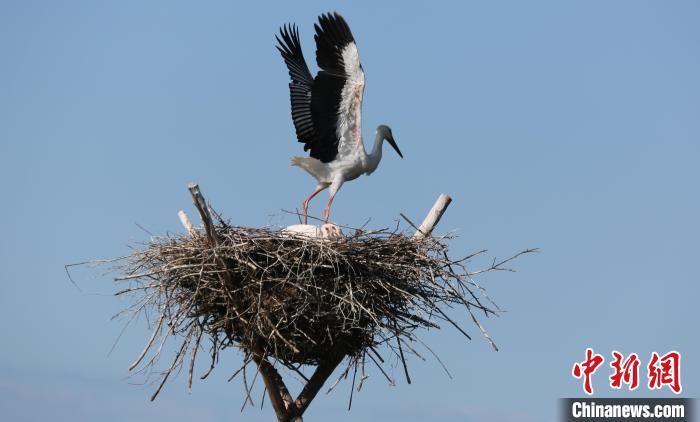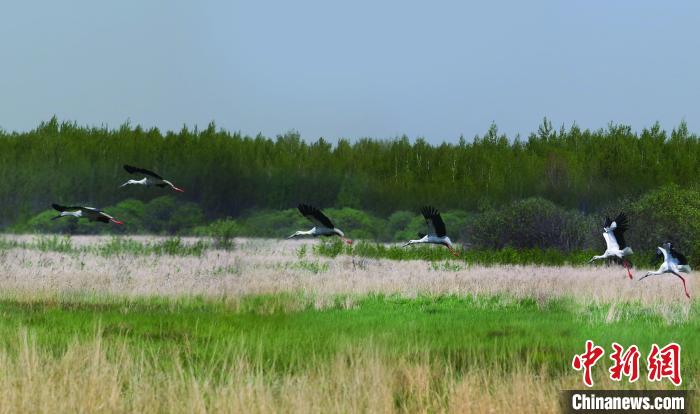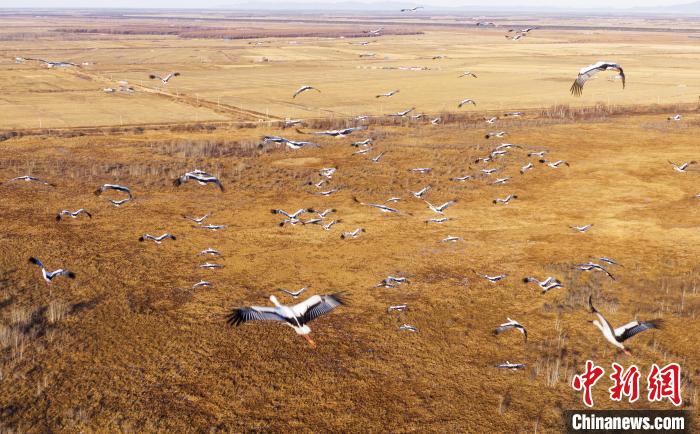Satellite-based tracking shows oriental white storks migrating further
Eight years of satellite-based tracking have shown that oriental white storks in the Honghe National Nature Reserve in northeast China’s Heilongjiang Province are expanding their migration areas beyond China, according to an official from the reserve’s management bureau.

Photo shows an oriental white stork in its nest. (Chinanews.com/courtesy of the management bureau of the Honghe National Nature Reserve)
Oriental white storks from the reserve have been found overwintering in the Republic of Korea and the Democratic People’s Republic of Korea for the first time, said Zhu Baoguang from the reserve.
The reserve began tracing oriental white storks with the help of satellite-based tracking equipment in 2015 to collect data on the birds’ breeding, foraging and international migration routes.
Zhu explained that the reserve attached satellite-based avian tracking devices to some young birds born in the reserve to monitor their movements.

Oriental white storks fly in the Honghe National Nature Reserve in northeast China’s Heilongjiang Province. (Chinanews.com/courtesy of the management bureau of the Honghe National Nature Reserve)
This year, 28 young oriental white storks were fitted with trackers in the reserve and one of them flew over the Yalu River on Oct. 5 and stayed in the Democratic People’s Republic of Korea for three days. This is the first time that such a migration route has been recorded.
Some young oriental white storks were found to have flown to Russia after leaving their nests. They stayed there until late October and then traveled south to spend the winter, mainly at Poyang Lake in east China’s Jiangxi Province.
The oriental white stork, a migratory bird species under first-class national protection in China, has been listed as endangered by the International Union for Conservation of Nature. In the early 1990s, there were only 3,000 oriental white storks around the world. Today, their global population is above 8,500.

Photo shows a flock of oriental white storks in autumn. (Chinanews.com/courtesy of the management bureau of the Honghe National Nature Reserve)
The Honghe National Nature Reserve is an important international wetland and is known as China’s home for oriental white storks.
Satellite tracking helps with the population recovery of oriental white storks and is important for the protection of the species in China and Russia’s Far East region.
Photos
Related Stories
- Chinese couple become 'gas station attendants' for migratory birds
- Red-billed blue magpies seen inside nature reserve in SW China's Chongqing
- Rare robin bird spotted in Qinghai
- In pics: several rare bird species spotted in Xiong'an New Area
- How to photograph birds
- In pics: Migratory birds fly to West Lake to overwinter
- Red-crowned cranes spotted at Zhalong National Nature Reserve in NE China's Heilongjiang
- Steps taken to welcome migratory birds to drought-hit lake
- In pics: gannets at Cape Kidnappers, New Zealand
- Nanchuan district of SW China's Chongqing becomes bird's paradise
Copyright © 2022 People's Daily Online. All Rights Reserved.









